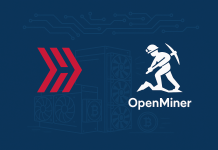[ad_1]
After the high note with which crypto ended 2017, 2018 has been a dour reminder that crypto markets remain unpredictable at best. From its peak at nearly $20,000 in December, bitcoin spent most of 2018 in a steady decline. Today, bitcoin’s price is closer to $3,000, and the tumble has caused a ripple effect that has affected every stakeholder in the market.
Crypto miners, who rely on the price of bitcoin and other cryptocurrencies to remain high enough to stay profitable, are now left holding the bag in more ways than one: pricy mining rigs and GPUs worth thousands, and the bitcoin they’ve mined with these tools. Now that prices have remained solidly below break-even rates for several months, miners must reflect on whether they can continue bankrolling increasingly expensive operations or they should simply cut their losses and run.
However, the simple cost of building these rigs—from purchasing and replacing parts to procuring good enough GPUs to be effective—makes leaving the game a difficult question. Even so, some miners are looking not to abandon their existing setups, but rather pivot them into something profitable while the market adjust to its new reality. With some innovative alternatives out there, miners may soon shed their crypto shackles and diversify operations.
Mining at a Loss
In early December, bitcoin blockchain observers noticed that the original cryptocurrency’s hash difficulty had dropped by more than 15%, the second-largest such contraction since October 2011. The difficulty is set dynamically, and it responds to actual fluctuations in hash rates, so a drop mirrors the activity on the network. Indeed, since November, Bitcoin’s hash rate has dropped by more than 30%, reflecting an exodus of miners from the market. The cause of this mass flight is the continued drop of mining revenues, which is nearly halved in December from November’s levels.
The short-term outlook is not optimistic, either. Despite the enthusiasm of some bullish industry observers, smaller miners are faced with a very real crisis right now, and the promise of future price bumps may not be enough to keep all of them operating on the bitcoin blockchain. For miners, energy, resources, and other overheads mean that running at a loss is not favorable in any situation. Despite miners seeing $4.7 billion in revenues in 2018, smaller mining operations cannot keep up with larger setups that have slowly centralized control of the market.
Instead, many smaller miners may be looking to make a soft landing elsewhere without having to sell off the equipment they’ve already purchased and are on the hook for. The problem with reselling is that many of the GPUs and ASIC processors used have significant wear on them, and the inflated market in which they were purchased has come back to earth, heavily affecting component prices.

Branching Out
The one commodity most miners have to offer, should they choose to move away from mining, is raw computing and processor power. The increasing complexity of hashing and verifying blocks means that most mining rigs today have gigabytes of computational power that can be used in several ways—especially since much of it comes from GPUs and not CPUs. This seems abstract, but a recent uptick in the need for heavy computing capacity stemming from emerging technology has made it a much more feasible reality. Technology such as artificial intelligence, machine learning, and neural networks require significantly more raw power than single computers can offer at reasonable prices. Instead, several companies, both on the blockchain and off, have started to specialize in renting out computing power to organizations and users in need.
On blockchain, there are several projects taking a novel approach to the computation problem. Tatau, for instance, is looking to reduce the cost of super-computing by leveraging blockchain GPU networks. The company’s platform lets users monetize their existing surplus GPU capacity and rent it to individuals who need it. The company is focused on AI, a notoriously resource-intensive technology that is nonetheless becoming vital to many fields. For miners who continue to shut down their rigs and operations, the shift to computing power would take seconds and could be a good alternative for times when mining becomes unprofitable.
Others have also offered similar solutions though with different areas of focus. Leonardo Render, for instance, focuses more heavily on providing computing power for graphics work and 3D modeling. The company is also more focused on providing a ready-made solution, as it has contracted the services of a GPU farm to bolster its initial launch. Golem offers computing capacity for a variety of work though it is aimed largely at more academic projects. However, in all cases, the use of blockchain means miners can easily convert their operations back and forth, meaning they can be ready to get back in the game should crypto prices bounce back.
Diversify or Sink
The reality for crypto miners is that while the market remains volatile, so will their fortunes. While it may be highly profitable to continue mining in a bull market, the extended period of losses the industry is experiencing makes it hard to generate revenues. Moreover, the status quo favors larger miners who can buffer their costs and remain operational even in downturns.
For smaller miners, the answer of survival may rest on their ability to diversify their computing power without having to declare their expenses and efforts a sunk cost. By finding projects and platforms that take advantage of their existing tools, miners can weather the ongoing storm and still be prepared for a future where crypto bounces back.
Images from Shutterstock.
[ad_2]
Source link




